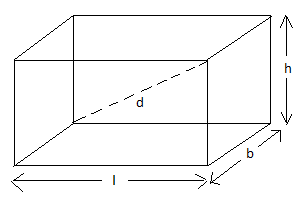
The sum of length, breadth and depth of a cuboid is 19 cm and the length of its diagonal is 11 cm. Find the area of the cuboid.
Answer
492.6k+ views
Hint: Take length, breadth and depth as l, b and h. Thus we get the relation connecting them. Expand \[{{\left( l+b+h \right)}^{2}}\] and substitute the values. Simplify and get the total surface area as cuboid.
Complete step-by-step solution -
Let us consider the length of cuboid as ‘l’, breadth as ‘b’ and height of cuboid as ‘h’. From the figure you can find the length, breadth and height.

The diagonal of the cuboid is marked as ‘d’. It is given the sum of length, breadth and depth of cuboid is 19 cm, i.e. l + b + h = 19…….(1)
Now, the length of diagonal, d = 11 cm.
We know that the length of diagonal of cuboid \[=\sqrt{{{l}^{2}}+{{b}^{2}}+{{h}^{2}}}=11cm.......(2)\]
The total surface area of a cube is the area of all 6faces of the cuboid \[=2\left( lb+bh+lh \right)......(3)\]
Now from equation (2), \[\sqrt{{{l}^{2}}+{{b}^{2}}+{{h}^{2}}}=11\]
Now square both sides of the equation (2).
\[{{l}^{2}}+{{b}^{2}}+{{h}^{2}}={{(11)}^{2}}=121\].
Now by basic trigonometric formula we know that,
\[\begin{align}
& {{\left( l+b+h \right)}^{2}}={{l}^{2}}+{{b}^{2}}+{{h}^{2}}+2lb+2bh+2lh \\
& {{\left( l+b+h \right)}^{2}}={{l}^{2}}+{{b}^{2}}+{{h}^{2}}+2\left( lb+bh+hl \right).....(4) \\
\end{align}\]
Now let us substitute all values from equation (1), (2) to equation (4).
\[l+b+h=19\] and \[l+b+h=121\]
\[\begin{align}
& \therefore {{\left( 19 \right)}^{2}}=121+2\left( lb+bh+lh \right) \\
& \therefore 2\left( lb+bh+lh \right)=361-121=240 \\
\end{align}\]
From equation (3) we know that TSA of cuboid = \[2\left( lb+bh+lh \right)\]
\[\therefore 2\left( lb+bh+lh \right)=240\]
TSA of cuboid = 240
i.e. the area of the cuboid = 240.
Thus we got the area of the cuboid as 240.
Note: We were only asked to find the area of the cuboid. So leave the answers as \[2\left( lb+bh+lh \right)\]. Don’t simplify again and make it complex. We haven’t been given sufficient data to find length, breadth and height. So get the area. Remember the formula for finding the length of diagonal of a cuboid.
Complete step-by-step solution -
Let us consider the length of cuboid as ‘l’, breadth as ‘b’ and height of cuboid as ‘h’. From the figure you can find the length, breadth and height.

The diagonal of the cuboid is marked as ‘d’. It is given the sum of length, breadth and depth of cuboid is 19 cm, i.e. l + b + h = 19…….(1)
Now, the length of diagonal, d = 11 cm.
We know that the length of diagonal of cuboid \[=\sqrt{{{l}^{2}}+{{b}^{2}}+{{h}^{2}}}=11cm.......(2)\]
The total surface area of a cube is the area of all 6faces of the cuboid \[=2\left( lb+bh+lh \right)......(3)\]
Now from equation (2), \[\sqrt{{{l}^{2}}+{{b}^{2}}+{{h}^{2}}}=11\]
Now square both sides of the equation (2).
\[{{l}^{2}}+{{b}^{2}}+{{h}^{2}}={{(11)}^{2}}=121\].
Now by basic trigonometric formula we know that,
\[\begin{align}
& {{\left( l+b+h \right)}^{2}}={{l}^{2}}+{{b}^{2}}+{{h}^{2}}+2lb+2bh+2lh \\
& {{\left( l+b+h \right)}^{2}}={{l}^{2}}+{{b}^{2}}+{{h}^{2}}+2\left( lb+bh+hl \right).....(4) \\
\end{align}\]
Now let us substitute all values from equation (1), (2) to equation (4).
\[l+b+h=19\] and \[l+b+h=121\]
\[\begin{align}
& \therefore {{\left( 19 \right)}^{2}}=121+2\left( lb+bh+lh \right) \\
& \therefore 2\left( lb+bh+lh \right)=361-121=240 \\
\end{align}\]
From equation (3) we know that TSA of cuboid = \[2\left( lb+bh+lh \right)\]
\[\therefore 2\left( lb+bh+lh \right)=240\]
TSA of cuboid = 240
i.e. the area of the cuboid = 240.
Thus we got the area of the cuboid as 240.
Note: We were only asked to find the area of the cuboid. So leave the answers as \[2\left( lb+bh+lh \right)\]. Don’t simplify again and make it complex. We haven’t been given sufficient data to find length, breadth and height. So get the area. Remember the formula for finding the length of diagonal of a cuboid.
Recently Updated Pages
What percentage of the area in India is covered by class 10 social science CBSE

The area of a 6m wide road outside a garden in all class 10 maths CBSE

What is the electric flux through a cube of side 1 class 10 physics CBSE

If one root of x2 x k 0 maybe the square of the other class 10 maths CBSE

The radius and height of a cylinder are in the ratio class 10 maths CBSE

An almirah is sold for 5400 Rs after allowing a discount class 10 maths CBSE

Trending doubts
The Equation xxx + 2 is Satisfied when x is Equal to Class 10 Maths

Why is there a time difference of about 5 hours between class 10 social science CBSE

Change the following sentences into negative and interrogative class 10 english CBSE

Write a letter to the principal requesting him to grant class 10 english CBSE

Explain the Treaty of Vienna of 1815 class 10 social science CBSE

Write an application to the principal requesting five class 10 english CBSE




